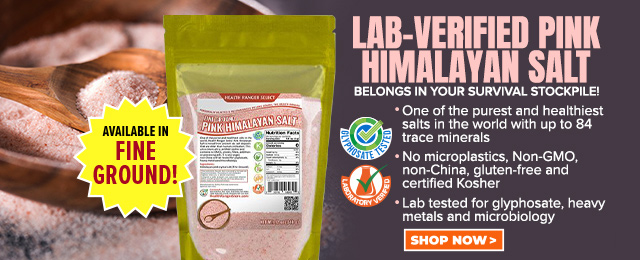
Pink slime, meat glue and more: Public reactions force Big Food to make changes
Sunday, May 20, 2012 by: J. D. Heyes
Tags: pink slime, meat glue, factory food
- Newly released JFK files reveal Pentagon's role in creating Lyme disease and covid in the same lab
- Oncologist warns of ‘terrifyingly aggressive’ cancers in children, linked to immune suppression from COVID vaccines
- Trump administration CUTS FUNDING to Gavi, the Vaccine Alliance - a major blow to the Bill Gates-backed entity
- NIH study, buried for decades, reveals that Flu Shots INCREASE elderly deaths, not prevent them
- Health Ranger Report: Ashton Forbes discusses TELEPORTATION ORBS and their role in MH370 disappearance
- Musk targets “strangely wealthy” lawmakers in DOGE probe, names Pelosi, McConnell, Schumer
- COVID-19 scandal linked to CANCER SURGE: Billionaire researcher sounds alarm
- Millionaire fitness coach charged in Tesla vandalism incident as anti-Musk attacks escalate
- “Ethically sourced” human “bodyoids” could usher in a new era of medical exploitation, raising disturbing ethical questions
- EPA banned chemical linked to cancer, Parkinson's and fatal heart defects in babies - now industry is lobbying to get it reinstated
- Woman contracts WORLD'S DEADLIEST VIRUS after unknowingly being given the WRONG VACCINE
- At least 75 percent of Americans are unknowingly MEDICATED FOR STUPIDITY by fluoridated water – Utah now banning it
- DARPA: The shadowy innovator behind the world’s most advanced military technologies
- Ancient kitchen secrets REVEALED: How garlic, ginger and green onions fight cancer and heart disease
- Civil war is here – Multiple events, from conservatives being “swatted,” to attacks against Telsa owners, happening across America as Dem politicians are telling supporters to ‘fight in the streets”
- Tackling the rubber waste crisis: Groundbreaking study reveals eco-friendly method to recycle tires
- RFK Jr. is pushing Big Pharma ad ban - and corporate media is panicking
- U.K. unveils controversial pandemic preparedness tool: A double-edged sword?
- Newly released JFK files reveal Pentagon's role in creating Lyme disease and covid in the same lab
- Analysis: The coming economic collapse, a mass uprising and Trump's three secret weapons to halt the growing revolt
- Trump's greatest betrayal so far: Accelerating Middle East wars, silencing dissent, and serving Zionist masters
- CDC finally halts $11 billion COVID funding scam as health officials admit the ‘pandemic’ was a fraud
- The hidden dangers in your kitchen: How cooking methods impact diabetes, cancer and aging
- Kiss Your Genetic Privacy Good-Bye! 23andMe Gets Green Light to Sell Your Intimate Genetic Details to Anyone They Want
- DEADLY DECEPTION: How COVID vaccines increased mortality rates and why authorities hid the truth
- Dr. Suzanne Humphries makes bombshell appearance on Joe Rogan podcast, exposing vaccine industry deception back to POLIOMYELITIS
- Trump nominates VACCINE ZEALOT Susan Monarez to lead the CDC, sidelining RFK Jr.'s reform efforts
- Here are TEN all-natural ways to protect your garden without using harmful chemicals
- Woman contracts WORLD'S DEADLIEST VIRUS after unknowingly being given the WRONG VACCINE
- Senate Democrats deny censorship industrial complex existed, defend government's role in silencing dissent
- Black cumin seed oil emerges as a powerful ally against breast cancer and chronic inflammation
- Sugar-free deception: Artificial sweeteners hijack hunger signals, fuel obesity epidemic, study warns
- “Independent” anti-Russia outlet MEDUZA faces COLLAPSE as US funding dries up
- The Health Ranger releases “Vaccine Zombie” song and music video, using AI-animated zombies for the music video
- Discovery of vast underground city beneath Giza pyramids challenges human history
- Key nodes of Federal Government censorship
- Newly released JFK files reveal Pentagon's role in creating Lyme disease and covid in the same lab
- California's social media censorship law struck down: A victory for free speech or a threat to online safety?
- EPA advisor admits the agency is funneling billions to climate groups ahead of Trump’s return to White House
- The Health Ranger releases “Vaccine Zombie” song and music video, using AI-animated zombies for the music video
- Dr. Mike Yeadon releases 15-minute testimony - WATCH - about genocidal intent of COVID “vaccines”
- Florida takes a stand: DeSantis proposes permanent ban on mRNA vaccine mandates
- “Why we influenced the 2020 elections”: Facebook files reveal the coordinated effort to bury the Hunter Biden laptop story
- Mike Adams releases country western hit single: Goin’ Back in Time is Comin’ Home
- The pandemic as a tool for INDOCTRINATION: Understanding “The Indoctrinated Brain” by Dr. Michael Nehls
- Unpacking the Lies That We’ve Been Fed – new song and music video released by Mike Adams, the Health Ranger
- Mike Adams releases music poetry sensation: A Child of God
- House Intelligence Committee calls for the ARREST and PROSECUTION of Dr. Anthony Fauci
- Rep. Nancy Mace introduces bill to ban biological males from female facilities on federal property
- Michigan sheriff announces criminal investigation into 2020 election crimes, Dominion Voting Systems
- Peter Rost exposes Big Pharma corruption in his book “The Whistleblower: Confessions of a Healthcare Hitman”
- Migrants are taking advantage of recent hurricanes to scam residents and loot their homes
- Sugarcane extract superior to cholesterol-lowering drugs?
- Survival 101: Effective EMF blocking techniques
- Red Cross issues warning to stop blood plasma donations from vaccinated people
- Scientists confirm: GENIUS brain function can be spontaneously unleashed in humans without any apparent cause
- EPA advisor admits the agency is funneling billions to climate groups ahead of Trump’s return to White House
- HYSSOP: What research reveals about the health benefits of this ancient holy herb
- Two containers with completed ballots fall out of truck in Florida
- Fully vaccinated about to see “tsunami” of illness and death, warns virologist
- Global leaders unite to clamp down on “misinformation” with UN-backed Cascais Declaration
- BREAKING: 2025 NDAA authorizes mandatory military draft of WOMEN across America… as Pentagon pursues global NUCLEAR war with both Russia and China at the same time
- Michael Yon warns of a ZIONIST TAKEOVER in Trump’s second administration
- BOMBSHELL: DNA testing kits are a SCAM to develop ethnic-specific bioweapons
- Ozempic and Wegovy weight loss drugs are injectable LIZARD VENOM PEPTIDES that may unleash a devastating wave of organ failure… side effects align with symptoms of SNAKE BITES
- Israeli soldiers accused of even more torture and abuse in the West Bank
- These 13 countries just signed an agreement to engineer a global FAMINE by destroying food supply
- NASA admits that climate change occurs because of changes in Earth’s solar orbit, and NOT because of SUVs and fossil fuels
- RFK Jr. clears key hurdle: Sen. Susan Collins backs controversial HHS nominee, signaling a new era for health policy
- Sermon 30: How Jesus reveals Caesar’s FAKE CURRENCY and FALSE AUTHORITY
- Coriander seeds: Ancient medicine backed by modern science
- Arizona officials claim Maricopa County needs 10-13 days to tabulate results of the election
With that in mind, consider some of the things people are finding in food these days - not on a dare, but as byproducts of food preparation. Things like pink slime, food coloring from crushed beetles, "tuna scrape" - briefly used and once called the pink slime of the sushi industry - and now "meat glue," a substance the industry officially calls transglutaminase, "an enzyme that binds formerly unconnected pieces of meat to make them look like one solid chunk," the Chicago Tribune reported.
Whatever the "grossness," folks are more and more often wanting to know what is in the food they eat, and it's no small wonder why they are asking. Meat glue?
Health concerns may be a 'moot' point
"I'm beginning to see now that consumers are pushing back," Michael Doyle, Ph.D., director of the Center for Food Safety at the University of Georgia, said in an interview with the Huffington Post."They want more transparency. Pink slime was a great example. It wasn't whether the food was safe or not but, 'Hey, they're putting ammonia in my ground beef, and I don't like that,'" he said.
Who would? After all, isn't ammonia some sort of cleaner? Should the food industry manufacture their products with ingredients just a little less likely to hurt our health?
The health aspect may be "moot," HuffPost blogger and director of the Yale Prevention Research Center, David Katz, M.D., said. After all, "[I]f people don't like the idea of eating it, it will go away."
But he may have a point. He says - and NaturalNews is a good example as well - that such blogs and other sites dedicated to "outing" the food industry for its ingredient quirks is a good thing that is driving change within the industry.
"Foodies and people who are maybe more purists in their food are more concerned, spending more time on the blogs," Katz writes. "They use the blogs to get their perspective out and put pressure on the retailers, who put pressure on the processors."
Consumer groups are adding pressure of their own.
The Center for Science in the Public Interest (CSPI), for instance, is pushing for new policies that promote sustainable food and changes to the food-processing industry, says executive director and HuffPost blogger Michael F. Jacobson. He says the pink slime was the siren in the night for millions of consumers.
"And they clearly didn't like what they saw," he said.
More to come?
Some industry experts say, however, that change may be slow (isn't it always) and, well, gross. One in particular - CSPI staff attorney Sarah Klein - hints that consumers are likely to be very surprised (and not in a good way) at all of the nasty ingredients used by the food industry, if the truth were ultimately known."I want to say to people, if you were grossed out by pink slime, there's more to come," she told Cleveland.com.
"In pink slime, we are looking at a product that is unsavory, but not unsafe -- we don't have any evidence to suggest the ammonia treatment is dangerous," she said. "But the public outcry over this has illustrated a couple things: consumers want to know what's in their food, and the USDA needs to take a much closer look at labeling -- not just of ground beef, but of all labeling."
Katz says the best way to avoid the nastiness is to change your eating habits to foods that "are generally not prone to any such adulterations."
That means you should get your food the way you get your news: Natural.
Sources for this article include:
http://www.huffingtonpost.com
http://online.wsj.com
http://articles.chicagotribune.com
Pink slime at FETCH.news
Get independent news alerts on natural cures, food lab tests, cannabis medicine, science, robotics, drones, privacy and more.
Take Action: Support Natural News by linking to this article from your website
Permalink to this article:
Embed article link: (copy HTML code below):
Reprinting this article:
Non-commercial use OK, cite NaturalNews.com with clickable link.
Follow Natural News on Facebook, Twitter, Google Plus, and Pinterest
Science News & Studies
Medicine News and Information
Food News & Studies
Health News & Studies
Herbs News & Information
Pollution News & Studies
Cancer News & Studies
Climate News & Studies
Survival News & Information
Gear News & Information
News covering technology, stocks, hackers, and more



"Big Tech and mainstream media are constantly trying to silence the independent voices that dare to bring you the truth about toxic food ingredients, dangerous medications and the failed, fraudulent science of the profit-driven medical establishment.
Email is one of the best ways to make sure you stay informed, without the censorship of the tech giants (Google, Apple, Facebook, Twitter, YouTube, etc.). Stay informed and you'll even likely learn information that may help save your own life."
–The Health Ranger, Mike Adams













































